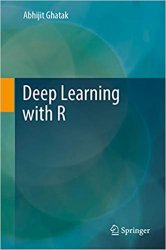 Название: Deep Learning with R Название: Deep Learning with R
Автор: Abhijit Ghatak
Издательство: Springer
ISBN: 9811358494
Год: 2019
Страниц: 259
Язык: английский
Формат: pdf (true), epub
Размер: 59.9 MB
Deep Learning with R introduces deep learning and neural networks using the R programming language. The book builds on the understanding of the theoretical and mathematical constructs and enables the reader to create applications on computer vision, natural language processing and transfer learning.
Deep learning is a specific subfield of machine learning, which makes use of tens/hundreds of successive layers of representations. The specification of what a layer does to its input is stored in the layer’s parameters. Learning in deep learning can also be defined as finding a set of values for the parameters of each layer of a deep learning model, which will result in the appropriate mapping of the inputs to the associated answers (outputs). Deep learning has been proven to be better than conventional machine learning algorithms for these “perceptual” tasks, but not yet proven to be better in other domains as well.
The book starts with an introduction to machine learning and moves on to describe the basic architecture, different activation functions, forward propagation, cross-entropy loss and backward propagation of a simple neural network. It goes on to create different code segments to construct deep neural networks. It discusses in detail the initialization of network parameters, optimization techniques, and some of the common issues surrounding neural networks such as dealing with NaNs and the vanishing/exploding gradient problem. Advanced variants of multilayered perceptrons namely, convolutional neural networks and sequence models are explained, followed by application to different use cases. The book makes extensive use of the Keras and TensorFlow frameworks.
This book requires an intermediate level of skill in R and no previous experience of deep learning.
Contents:
1 Introduction to Machine Learning 1
1. 1 Machine Learning 1
1. 1. 1 Difference Between Machine Learning and Statistics 2
1. 1. 2 Difference Between Machine Learning and Deep Learning 3
...
1. 11. 6 Summarizing the Measurement of Loss 20
2 Introduction to Neural Networks 23
2. 1 Introduction 23
2. 2 Types of Neural Network Architectures 25
2. 2. 1 Feedforward Neural Networks (FFNNs) 25
2. 2. 2 Convolutional Neural Networks (ConvNets) 25
2. 2. 3 Recurrent Neural Networks (RNNs) 25
...
2. 9 Writing a Simple Neural Network Application 54
3 Deep Neural Networks-I 65
3. 1 Writing a Deep Neural Network (DNN) Algorithm 65
3.2 Overview of Packages for Deep Learning in R 80
3.3 Introduction to Keras 80
...
4 Initialization of Network Parameters 87
4. 1 Initialization 87
4. 1. 1 Breaking Symmetry 91
4. 1. 2 Zero Initialization 91
4. 1. 3 Random Initialization 93
4. 1. 4 Xavier Initialization 95
...
4. 2. 7 NaN Introduced by AllocEmpty 101
5 Optimization 103
5. 1 Introduction 103
5. 2 Gradient Descent 104
5. 2. 1 Gradient Descent or Batch Gradient Descent 104
5. 2. 2 Stochastic Gradient Descent 105
...
5. 6 Gradient Checking 144
6 Deep Neural Networks-II 149
6. 1 Revisiting DNNs 149
6.2 Modeling Using Keras 156
6.3 Introduction to TensorFlow 164
6.3.1 What is Tensor ‘Flow’? 165
6.3.2 Keras 166
...
7 Convolutional Neural Networks (ConvNets) 171
7. 1 Building Blocks of a Convolution Operation 171
7. 1. 1 What is a Convolution Operation? 171
7. 1. 2 Edge Detection 173
...
7. 6. 3 Generating Art Using Neural Style Transfer 204
8 Recurrent Neural Networks (RNN) or Sequence Models 207
8. 1 Sequence Models or RNNs 207
8. 2 Applications of Sequence Models 209
8. 3 Sequence Model Architectures 209
...
8. 8. 4 Analyzing Word Analogies Using Word Vectors 233
8. 8. 5 Debiasing Word Vectors 234
9 Epilogue 239
References 243
Скачать Deep Learning with R
|